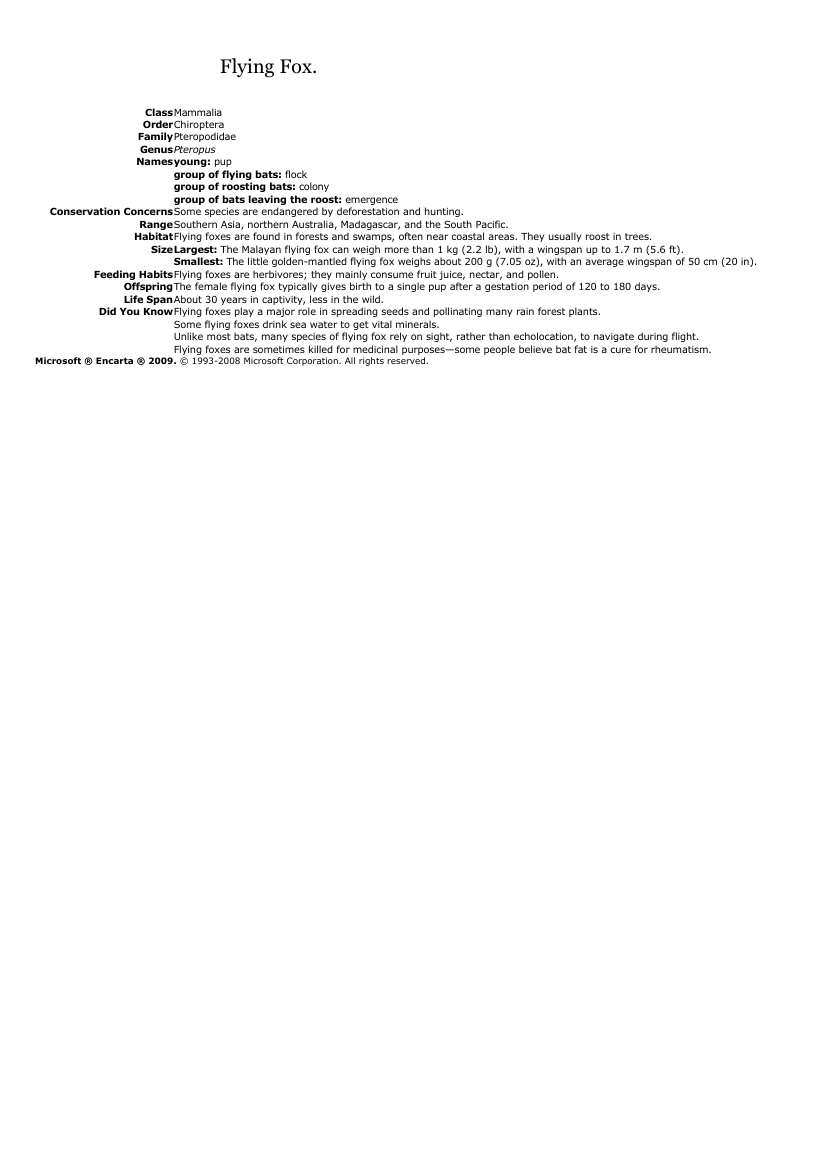Flying Fox.
Publié le 06/12/2021

Extrait du document
Ci-dessous un extrait traitant le sujet : Flying Fox.. Ce document contient 220 mots. Pour le télécharger en entier, envoyez-nous un de vos documents grâce à notre système d’échange gratuit de ressources numériques ou achetez-le pour la modique somme d’un euro symbolique. Cette aide totalement rédigée en format pdf sera utile aux lycéens ou étudiants ayant un devoir à réaliser ou une leçon à approfondir en : Echange
Flying Fox.
Class Mammalia
Order Chiroptera
Family Pteropodidae
Genus Pteropus
Names young: pup
group of flying bats: flock
group of roosting bats: colony
group of bats leaving the roost: emergence
Conservation Concerns Some species are endangered by deforestation and hunting.
Range Southern Asia, northern Australia, Madagascar, and the South Pacific.
Habitat Flying foxes are found in forests and swamps, often near coastal areas. They usually roost in trees.
Size Largest: The Malayan flying fox can weigh more than 1 kg (2.2 lb), with a wingspan up to 1.7 m (5.6 ft).
Smallest: The little golden-mantled flying fox weighs about 200 g (7.05 oz), with an average wingspan of 50 cm (20 in).
Feeding Habits Flying foxes are herbivores; they mainly consume fruit juice, nectar, and pollen.
Offspring The female flying fox typically gives birth to a single pup after a gestation period of 120 to 180 days.
Life Span About 30 years in captivity, less in the wild.
Did You Know Flying foxes play a major role in spreading seeds and pollinating many rain forest plants.
Some flying foxes drink sea water to get vital minerals.
Unlike most bats, many species of flying fox rely on sight, rather than echolocation, to navigate during flight.
Flying foxes are sometimes killed for medicinal purposes--some people believe bat fat is a cure for rheumatism.
Microsoft ® Encarta ® 2009. © 1993-2008 Microsoft Corporation. All rights reserved.
Flying Fox.
Class Mammalia
Order Chiroptera
Family Pteropodidae
Genus Pteropus
Names young: pup
group of flying bats: flock
group of roosting bats: colony
group of bats leaving the roost: emergence
Conservation Concerns Some species are endangered by deforestation and hunting.
Range Southern Asia, northern Australia, Madagascar, and the South Pacific.
Habitat Flying foxes are found in forests and swamps, often near coastal areas. They usually roost in trees.
Size Largest: The Malayan flying fox can weigh more than 1 kg (2.2 lb), with a wingspan up to 1.7 m (5.6 ft).
Smallest: The little golden-mantled flying fox weighs about 200 g (7.05 oz), with an average wingspan of 50 cm (20 in).
Feeding Habits Flying foxes are herbivores; they mainly consume fruit juice, nectar, and pollen.
Offspring The female flying fox typically gives birth to a single pup after a gestation period of 120 to 180 days.
Life Span About 30 years in captivity, less in the wild.
Did You Know Flying foxes play a major role in spreading seeds and pollinating many rain forest plants.
Some flying foxes drink sea water to get vital minerals.
Unlike most bats, many species of flying fox rely on sight, rather than echolocation, to navigate during flight.
Flying foxes are sometimes killed for medicinal purposes--some people believe bat fat is a cure for rheumatism.
Microsoft ® Encarta ® 2009. © 1993-2008 Microsoft Corporation. All rights reserved.
↓↓↓ APERÇU DU DOCUMENT ↓↓↓
Liens utiles
- fox-terrier.
- Fox Terrier.
- Charles James Fox1749-1806Charles James Fox n'a exercé des fonctions ministérielles que pendant trois brèves périodes-- en 1782, 1783 et 1806 -- dont la durée totale n'atteignit pas vingt mois et l'on pourraits'étonner de le voir rangé parmi les grands hommes d'État.
- Edward Fox1496-1538Edward Fox, qui était le secrétaire de Wolsey, fut un des artisans du divorce d'Henry VIII.
- William Henry Fox Talbot (1800-1877)


